13 September 2013
In response to great demand, we have decided to publish on our site the long and extraordinary interviews that appeared in the print magazine from 2009 to 2011. Forty gripping conversations with the protagonists of contemporary art, design and architecture. Once a week, an appointment not to be missed. A real treat. Today it’s Jeffrey Inaba’s turn.
Klat #02, spring 2010.
He’s always traveling. From one side of the USA to the other. At age 46 Jeffrey Inaba, the internationally renowned artist and urban planner, divides his life between Los Angeles, where he has founded the Inaba studio specializing in strategic development, architecture and urban design, and New York, where he directs C-Lab, the visual research lab at Columbia University. «Here we study development models of cities in relation to the geopolitical system and the global economy», he says about C-Lab. Populated by students from all over the world, C-Lab is much more than a university think tank. «Together with my students, we try to understand what direction we are moving in, what the future holds and what can be done to improve the state of the planet». Alongside his consulting work for multinationals like Coca-Cola, Samsung or Nissan, Inaba is the features editor of Volume, a «utopian exercise book» – as he likes to call it – done in collaboration with Archis, C-Lab and AMO, the spin-off of OMA, the studio of Rem Koolhaas.
Volume has a very free form. You often rely on mental associations and the eloquence of images. It’s almost like a visual stream of consciousness. I was very impressed by the fact that a couple of years ago you devoted a theme issue to the subject of agitation (Volume issue #10, March 2007). In your introduction you wrote that a lack of agitation should make us feel agitated, make us worry. Why?
“Agitation” is a term that is very rich in meanings. At least for my generation and the previous one. For me, it sums up an active, free worldview, not in line with the dominant thinking. We decided to do an issue on agitation as an antidote to the culture of consensus. I believe that in this historical moment there is a widespread tendency to erase cultural differences, in favor of insipid forms of compromise. I think it is fundamental to get back the energy to produce oblique, transverse thoughts. With this issue we wanted to suggest that it is no longer the time to be too polite, but time to pay attention to the substance of relationships. To start clashing again, to open up new forms of debate. Agitation can become a modus operandi to produce fresh ideas.
But what is the situation like in the United States now? Do you believe this administration can encourage a revival of cultural debate?
Actually, I think it is not right to expect change to come from above. Instead, I think it’s necessary to manage to stimulate cultural debate through capillary, transverse operations. Volume has precisely this goal: to interpret the flow of information from the reality around us and to offer new opportunities for discussion. And also for clashes. We would like to be cultural agitators. In this moment, we feel the need to set out new challenges, using all the available channels of communication.
How do you combine your work as an architect with that of a cultural agitator?
I believe constructing a beautiful building is not very useful if we don’t know about the territory where it is inserted. Take the suburbs. In this case, observation can help us to understand the deeper dynamics and to decode apparently invisible needs. Architecture comes later. It is the final phase of a rigorous process of analysis. To get a better understanding of the context in which I operate, I can use different tools: art, but also writing, video, photography, multimedia projects. These are means of production of meaning, essential for a deeper grasp of reality. In this perspective, artistic output becomes an opportunity for cultural agitation.
All your research is based on an elastic, multidisciplinary approach. Could you tell me something more about your working method?
For a long time, the study of American suburban areas was one of my main fields of investigation. The theme is vast and the social implications are very wide ranging. To analyze it in all its complexity I decided to use different channels, from writing to the production of installations, the organization of events, debates, conferences. The theoretical approach is not enough, on its own. So a few years ago, together with architect Peter Zellner, we founded Valdes, a non-profit organization that focuses on living conditions in suburban areas and tries to propose new design solutions. We both agree that it is clear that good design comes only after a phase of study and analysis of the social fabric. Our aim is to have an impact on the collective imagination, facilitating the creation of original habitation practices. Last year I continued with my studies of the suburbs, but, in that case, I decided to present the results in the form of an installation. I started with a very precise element: garbage. It seemed like an interesting angle for studying the lifestyle of the inhabitants. Getting your hands on the refuse material of a society can be exciting. It’s like working with your dark side. None of us particularly wants it to be put on display…
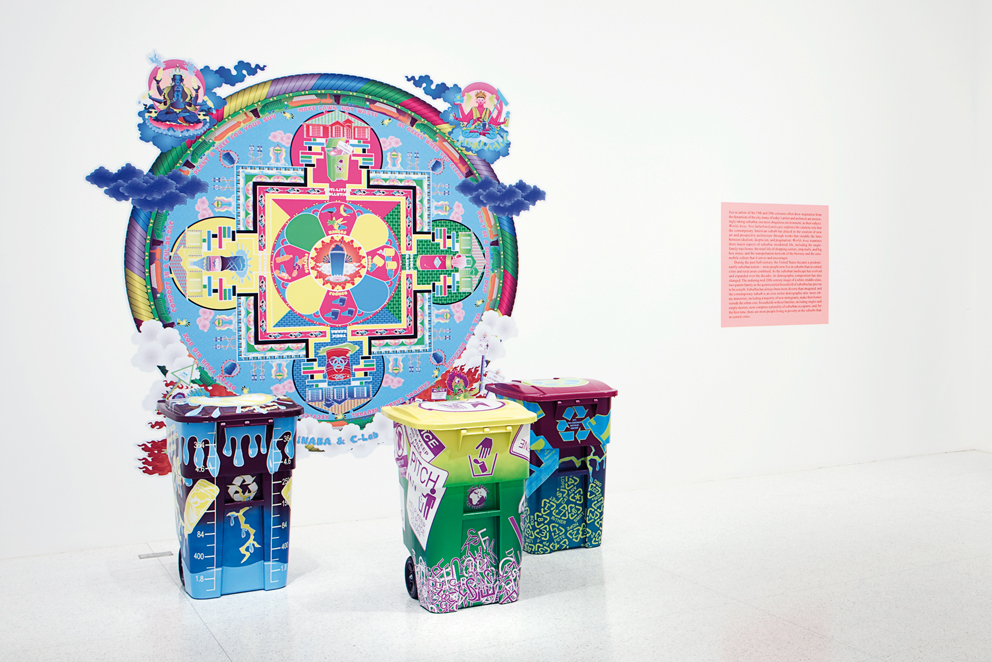
Jeffrey Inaba, Trash, 2008. Walker Art Center, Minneapolis.
But it sounds like an interesting reservoir, at least for psychoanalysts and architects…
Indeed. We dug into this material and we tried to define a sort of grammar of garbage. We studied individual behaviors, the packaging of refuse. We asked ourselves if trash cans are an example of functional design and if the infrastructures are suited to the needs. In the end, we summed up the results of our investigation in Trash, an installation commissioned by the Walker Art Center in Minneapolis for the exhibition Worlds Away: New Suburban Landscapes. We shed light on some interesting relationships, like the one between environmental awareness, consumption, waste and resource management on the part of institutions. To do it, we created three “modified” trash containers accompanied by infographics in the form of a hypercolored mandala. We used the cyclical nature of the mandala to show the similarities with the circle of the 4 Rs: reduce, reuse, recycle, recover. After all, isn’t the practice of recycling a form of continuous metamorphosis?
In your work you often use infographics. Why? Can you give me an example?
Infographics is a very effective tool for a clear, immediate translation of complex data. An example: for the opening of the New Museum in New York we were invited to propose a work to be installed in a corridor of the museum, and we decided to work on the theme of generosity. We wanted to discover what motivates a person, an institution or a community to make an altruistic gesture, what prompts someone to donate a part of his money or his free time. We analyzed the philanthropic behaviors of hundreds of organizations: from the donations for tax deductions on the part of multinational corporations, to those of political, religious and paramilitary groups. We were interested in shedding light on the relationship between those who give and those who receive. Especially in the cultural sphere. We gathered an incredible quantity of facts, graphs, statistics. We organized in the form of infographics to make it easier to access the content. The result was Donor Hall, an installation-manifesto to understand the passage from a market economy to a gift economy.
With the global financial crisis that passage is becoming a very timely possibility…
In effect, the theme seemed to fit perfectly with this moment in time. That’s why we decided to continue to explore it. We have gathered our contributions in an essay that was just published by Lars Müller. It is titled World of Giving and it examines the passage from the pursuit of individual wellbeing to new forms of collective generosity: from the actions of local volunteers to the megadonations of corporations, moving through the free economy of the web, based on the concept of sharing and free circulation of knowledge. A real revolution is happening and this book attempts to photograph its potential.
In your career you have often started with the analysis of complex social phenomena: besides generosity, you have investigated themes like ambition, vitality, suicide, envy. To do so you have used genres that are not precisely academic, like science fiction, comics, but also screenplays and collages. Do you believe this is the future of research?
As theorists, I think we have a responsibility to push the envelope. Going beyond conventional academic language is a way to find fresh, unprecedented viewpoints. After all, we are surrounded by surprisingly varied aesthetics, but they often end up being interpreted with a very limited language. In Volume, for example, we have created a special section. It’s called Alibi and it is constructed like a reportage in marginal, secondary places. Off any beaten tourism tracks. The idea is to produce an urban investigation in the form of a travel guide. We all travel a lot, but we have less and less time to explore the world. Low-cost airlines have transformed our agenda, pulverizing the idea of travel and transforming it into short stays of two or three days. Not enough to really get to know a place. The same thing happens when we travel for work. Trapped in business meetings and dinners, we don’t have time to explore the city. The title Alibi means an excuse to tell your boss, or yourself, to get some time to go and discover the city. It’s an invitation to be open, flexible, curious, especially in places off the beaten track, the ones tour operators would never take into consideration.
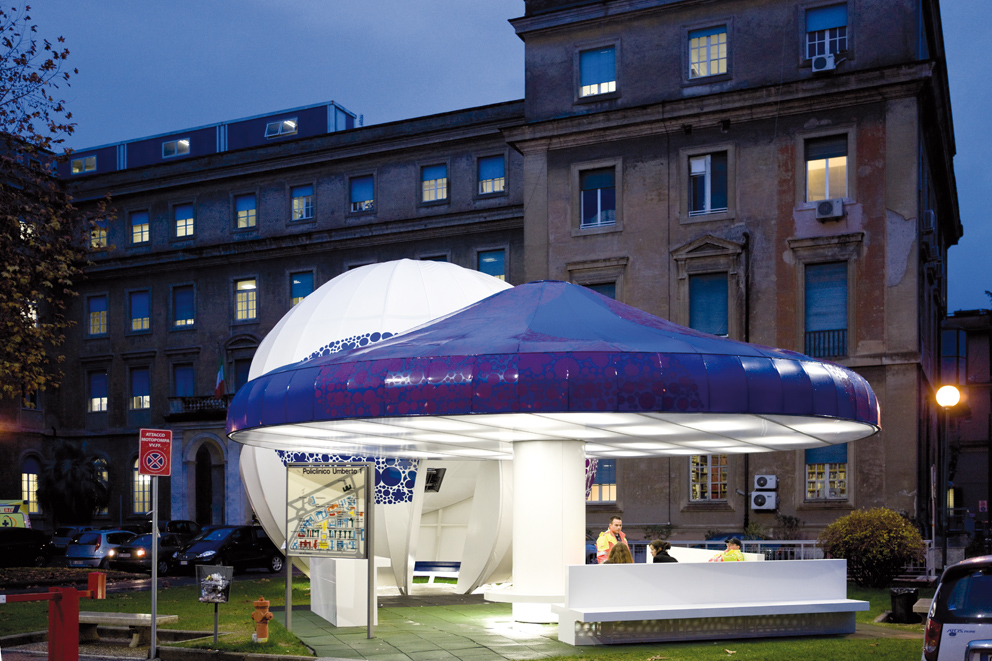
Jeffrey Inaba, The Waiting Room, 2008. Enel Contemporanea, Roma.
In effect, I was struck by the tour you did of Kazakhstan a few years ago…
There are not many reasons for visiting Kazakhstan. Even for the most adventurous travelers. There are few attractions, and the few tourist spots can be visited in less than one day. Unlike the neighboring regions, Kazakhstan has been occupied above all by peoples of nomadic origin. Urbanization dates back to the 19th century. Although the landscapes around the city of Almaty are incredibly beautiful in the spring, temperatures can reach +40°C in the summer and -40° in the winter. All these reasons were sufficient to catch our attention. So we began to ask questions: for example, how does the population live in such extreme conditions? The result is a photographic report on the Soviet constructions, but also on lifestyles, geopolitical conditions, the role of petroleum in this region. Astana, the capital, resembles Dubai. Its skyline is dominated by monolithic buildings that generate a rhetoric of power of great impact. But unlike Dubai, the buildings were designed to blend in a homogeneous whole, rather than competing for individual attention.
Actually all your work is studded by the presence of extreme environments: from the Kazakh steppe to the favelas of Brazil, to the desert ecosystem of the Gulf region…
I think extreme spaces are very stimulating objects of study. We can learn much from observation of a desert or an Asian steppe. Where the desert is concerned, in particular, we collaborate with the Archis Foundation and the AMO studio on the creation of Al Manakh, a multidisciplinary research platform on habitation practices in the Arab Emirates. We constantly monitor the relationship between natural environment and artificial habitat. The website www.almanakh.org is part of the network we are developing with C-Lab. In 2007 we published the first volume on analysis of urban planning in cities like Abu Dhabi, Doha, Dubai, Kuwait City. Now we are focusing on another aspect, connected with the flows of tourism. How do tourists move in these zones? What type of welcome do they find? How do they interact with local forms of living? How do they get oriented in these artificial paradises? The Netherlands Architecture Institute has organized a series of debates called Debate on Tour. Together with other colleagues, we are trying to outline the relationship between travelers and lived, toured, imagined space. We started with Venice, the city-icon of tourism representation.
In your research environments live in total symbiosis with the individuals that cross them. You almost seem more like a sociologist than an architect…
We’re interested in measuring the degree of wellbeing or malaise of a community, studying the repercussions on the social fabric, evaluating what mechanisms are triggered when an individual finds himself in a favela, a satellite neighborhood, a penthouse on Central Park, or in a hospital.
Speaking of hospitals, what was it like to work inside the Policlinico Umberto Primo in Rome?
When Francesco Bonami invited me to take part in the second edition of Enel Contemporanea I thought working inside a hospital would be a stimulating challenge, because I would be exposed to a series of complex dynamics. In a hospital everyone is waiting for something. The results of a test, an operation, a relative, a friend, the end of a shift. Usually this waiting happens in a state of anxiety. This is why we thought about making The Waiting Room. The objective was to create a place that would alleviate the sensation of general anguish, through distraction or recreation. I believe architecture can intervene in a decisive way in the collective imagination, attenuating social pressures and tensions. Based on these premises, we can operate successfully in a hospital facility, but also in an area impacted by economic crisis. In America the recession is revising scenarios, transforming areas of high residential density into ghost towns. Today we are experiencing a new aesthetics of disappearance. Is it an irreversible process? Can we change the state of things? There are many questions. Certainly we will need to rethink the forms of habitation. The first step is to create new green areas, infrastructures and sustainable mobility. But architecture can lend a hand on a much more subtle level, anticipating the demands of citizens.
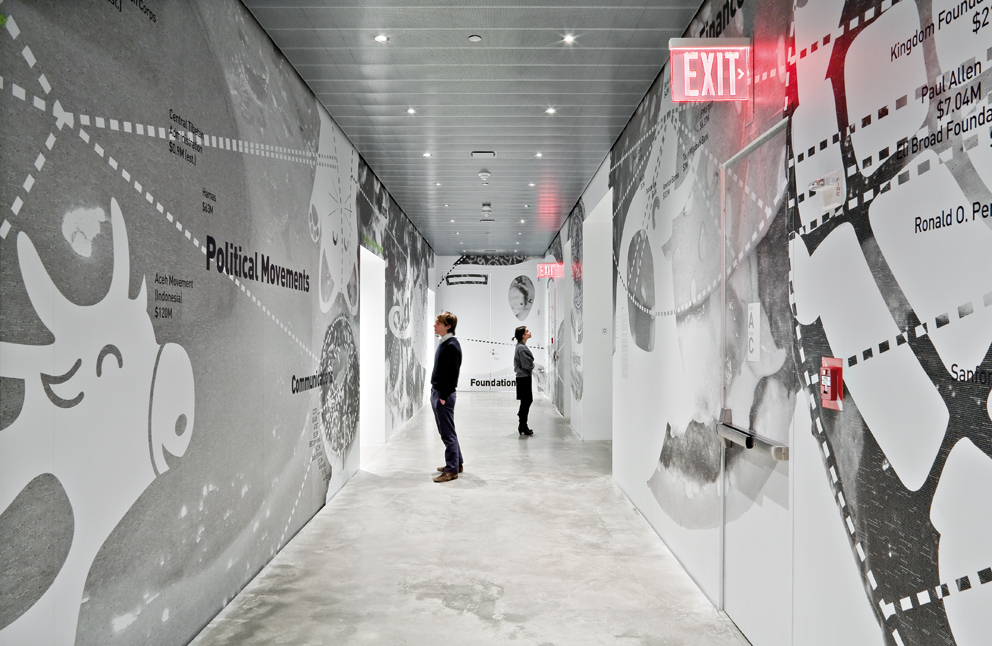
Jeffrey Inaba, Donor Hall, 2007. New Museum, New York
How?
Recently, for example, we presented a project for public transport in an area of North Carolina. This is a region with the typical characteristics of American suburbia: scattered buildings, low residential density, big deserted streets conceived for movement in cars. We studied the area and asked ourselves how we might introduce a light rail network in an environment dominated by big streets for SUVs. We developed a circular system capable of connecting the center to the outskirts. We laid the groundwork for a change; now we have to wait for the community to get the virtuous process started.
A Greek friend told me that during the Olympics in 2004 the new Athens subway was used only by tourists. The people of Athens preferred to continue using cars or taxis, even though the city was badly congested with traffic. The institutions had hoped for a much faster change. Actually, for a long time after the end of the Games the subway was still used mostly by students and tourists.
The success of these processes calls for long periods of waiting, because they act on a deep level that involves upbringing, habits, the lifestyles of a community. In the United States the new ecological awareness involves young people, above all, but it is producing very fast changes in large segments of the population. New York, for example, is doing an excellent job. The new bicycle paths that are appearing in Manhattan, beside the main traffic arteries, represent much more than an urban intervention. Inserted in that context, they function as activators of good habits.
Of course, in this way even the most avid motorists can see an alternative, right in front of them…
Yes, and if it works in Manhattan it becomes a model that can be exported into any big city in the world.
Your optimism goes hand in hand with your idea of “big thinking”. At least that’s how it seems, listening to what you tell your students…
Once, at Harvard, I proposed an exercise that started with a real event. In the 1990s the university purchased some land for building, but a local committee of residents blocked the expansion project for years. I asked my students how they would go about resolving the problem. For the school it was fundamental to overcome this obstacle, because having advanced infrastructures is the first step for staying competitive on the higher education market. The conclusion was: we have to alter the course of the river. In that way we could obtain a compact area for building, capable of uniting all the students on a single campus. The cost of the operation? One billion dollars. But that figure would be amortized over time, considering the fact that the Moses project would have guaranteed sufficient space for construction for the next 130 years. MIT did a similar operation in the 1920s, and now it has no real estate problems.
But in the end that proposal remained on the drawing board. The method, however, was used for other ambitious projects, like the one for the Saemangeum area in South Korea.
Yes. Saemangeum is a very controversial area. In this case we were faced by a delicate habitat that had a great influence on the urban design of the zone. It is a swampy area that limited the administration’s choices for a long time, leading to a situation of stasis. We proposed increasing the area for construction, to add 30,000 hectares. We suggested landfill in the marshlands, to push the available area for building toward the water, creating multitasking buildings, like solar energy farms surrounded by floating fields. We could take advantage of the potential of water to create energy and irrigate, thanks to a system with a continuous cycle of filtering and purification. In any case, the idea of the Fill in the Lake project is not to disrupt the natural habitat, but to exploit its potential.
On this topic, I have read some of your thoughts on sustainable design. Just what do you mean when you talk about «bad feng shui»?
In this moment we are running the risk of taking certain rhetoric on sustainability to extremes. It seems to be enough to call a project sustainable in order to gain special immunity. To avoid any kind of criticism. We have been abusing the term, of late. Actually, there are many cases of bad environmental practices. In China, for example, a dangerous trend is emerging: that of designing horizontal cities, very similar to the American suburbs. With the same problems in terms of traffic and movement between center and periphery. In this case, however, the single-family houses are built in perfect eco-friendly style. When I talk about bad feng shui I am referring precisely to this.
When did you decide to become an architect?
Actually that’s a rather complicated question. I think I decided when I was a child. Though at the time I did not know what type of architect I would become. After postgraduate studies in architecture at Harvard, and the first few years of my career, I had the good luck to be involved in some very high-level projects, like Project on the City, where I was co-director, together with Rem Koolhaas. We developed experimental lines of research, studying the impact of technologies on the contemporary city. I can say that I have always known what I wanted, but the ways of achieving my professional goals have only become clear over the last few years. I once heard a hairdresser say: «if heads didn’t have ears cutting hair would be a lot easier». The same thing happens in design: if there were no obstacles, everything would go smoothly. So, through experience, I have understood what kind of architect I want to be. One who studies the obstacles and tries to transform them into new resources, new opportunities.
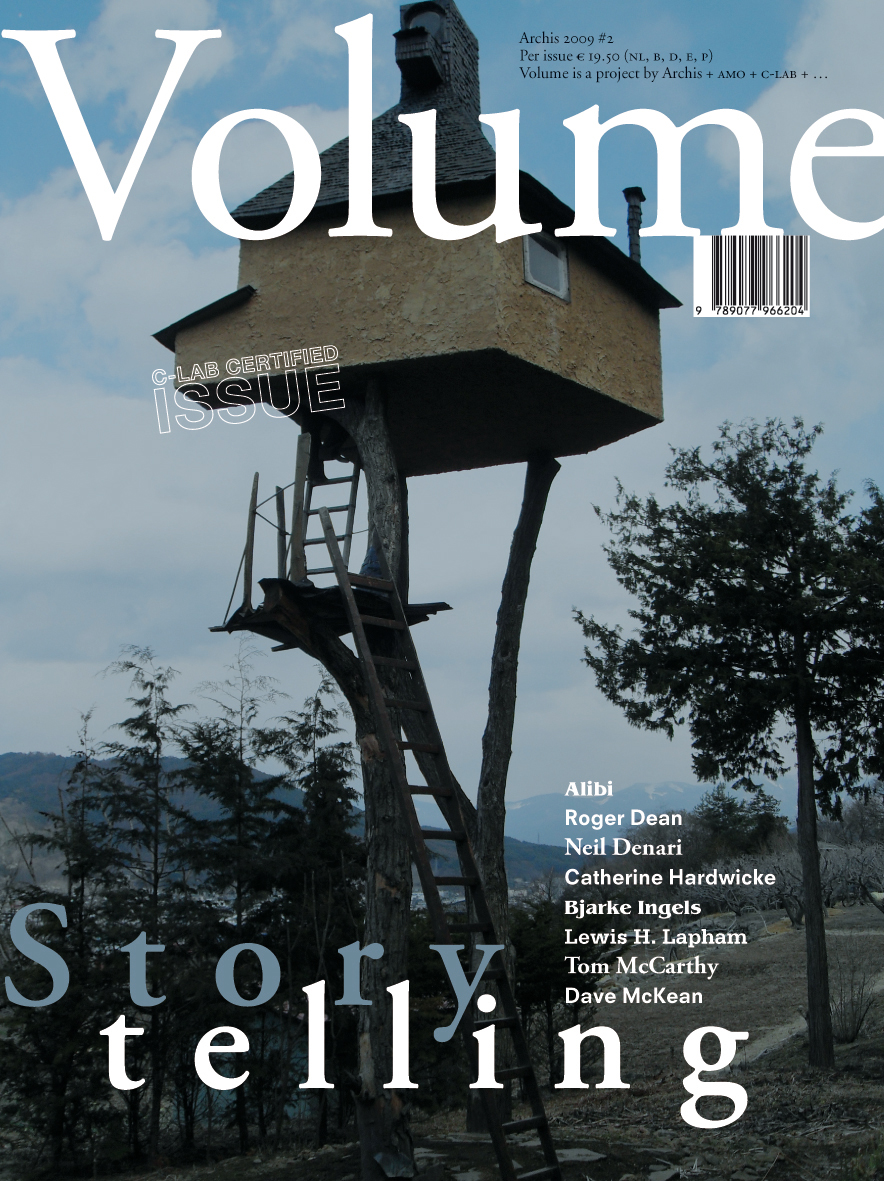
Volume magazine, issue #20, 2009
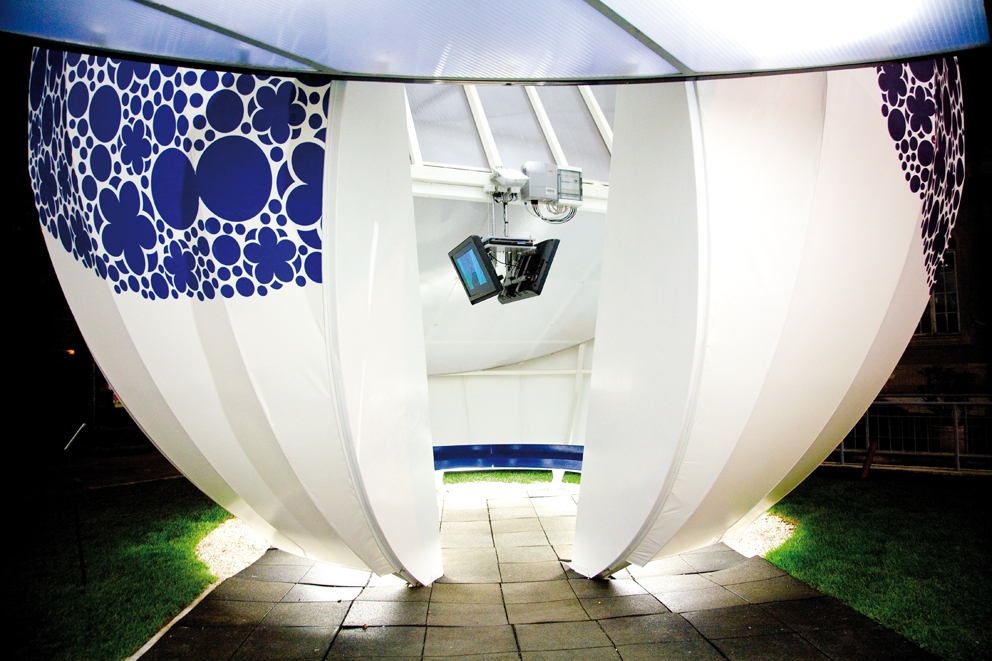
Jeffrey Inaba, The Waiting Room, 2008. Enel Contemporanea, Roma
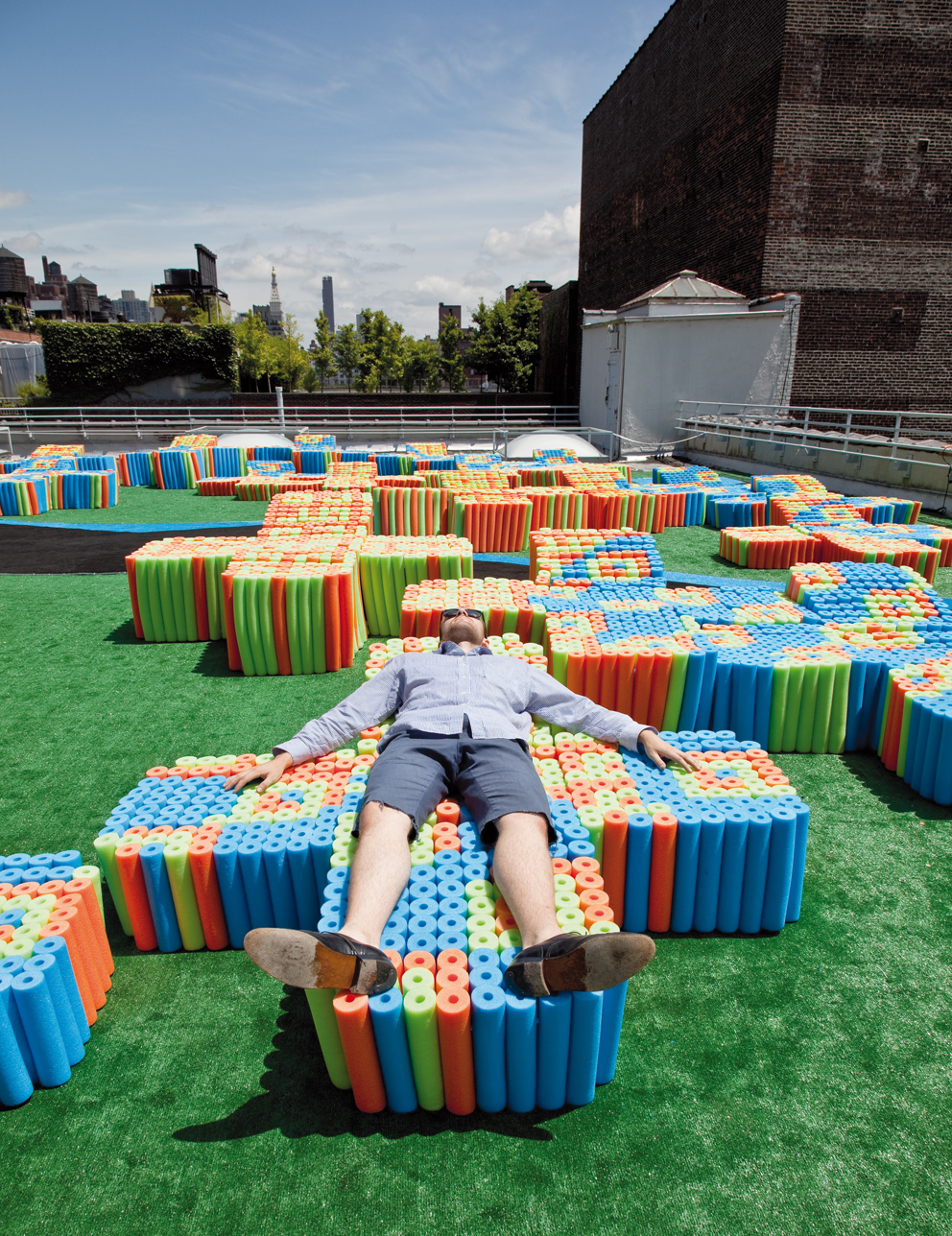
Jeffrey Inaba, Pool Noodle Rooftop, 2009. X-Initiative, New York.
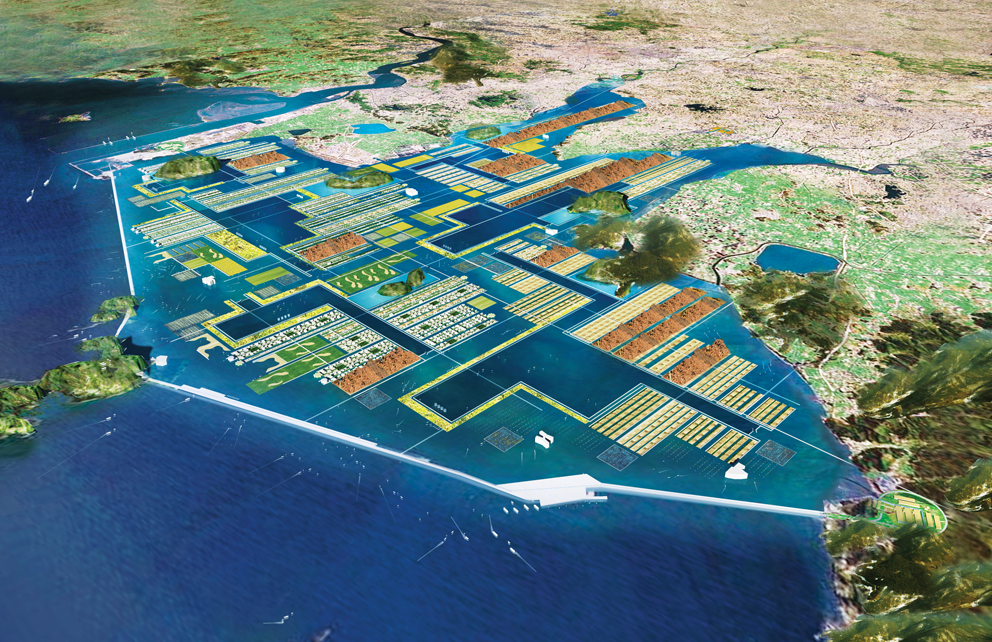
Jeffrey Inaba, Fill in the Lake, 2008. Rendering: C-Lab.